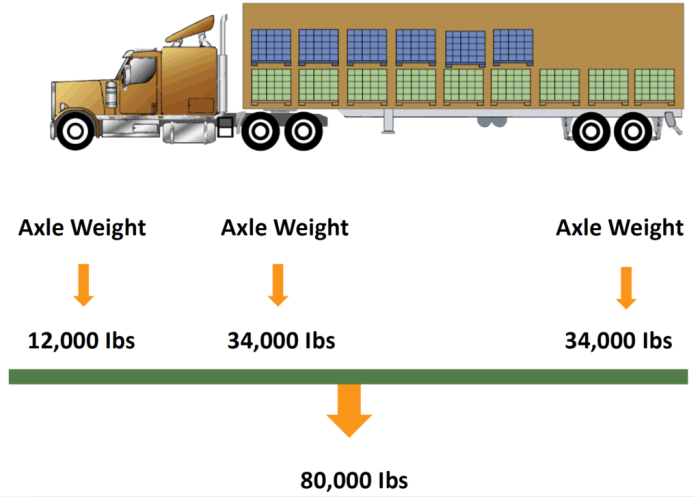A truck weighing 3.0 x 10 4 – In the realm of transportation, the significance of a truck weighing 3.0 x 10^4 cannot be understated. As we delve into the intricacies of this topic, we will uncover its impact on logistics, engineering, economics, and environmental sustainability.
This colossal vehicle, with its immense weight, plays a crucial role in the movement of goods and materials across vast distances, shaping the very fabric of our global supply chains.
Definition and Context
A truck is a heavy motor vehicle designed to transport goods or materials. It consists of a cab for the driver and passengers, a cargo area for the load, and an engine that powers the vehicle. Trucks come in various sizes and configurations, each suited to specific transportation needs.
Trucks play a crucial role in the transportation and logistics industries. They are responsible for hauling a wide range of goods, from raw materials to finished products, over long distances. The efficient movement of goods by trucks is essential for economic growth and development.
Types of Trucks
There are numerous types of trucks, each designed for a specific purpose. Some common types include:
- Semi-trailer trucks:These are large trucks that consist of a cab and a detachable trailer. They are commonly used to transport heavy or bulky loads.
- Box trucks:These are enclosed trucks with a rectangular cargo area. They are often used for local deliveries and moving.
- Flatbed trucks:These trucks have a flatbed instead of an enclosed cargo area. They are used to transport large or oddly shaped items that cannot fit inside a box truck.
- Dump trucks:These trucks have a hydraulically operated bed that can be raised and lowered. They are used to transport loose materials, such as sand, gravel, and soil.
Weight Measurement

The truck’s weight, as given, is 3.0 x 10 4. Converting it to standard form, we get 30,000. The weight is measured in pounds (lbs), which is the customary unit for weight in the United States.
Factors Affecting Truck Weight
Several factors can affect a truck’s weight, including:
- Cargo:The weight of the cargo being transported is a major factor in determining the overall weight of the truck.
- Fuel:The amount of fuel in the truck’s tank can also add significant weight.
- Equipment:The truck’s equipment, such as liftgates, refrigeration units, and other accessories, can contribute to its weight.
- Driver and passengers:The weight of the driver and any passengers in the truck should also be considered.
Truck Capacity and Load Distribution

Trucks play a crucial role in transportation, hauling significant loads over long distances. Understanding the truck’s capacity and proper load distribution is essential for safety, efficiency, and compliance with regulations.
The maximum load capacity of a truck is determined by its weight. Generally, a truck’s weight is categorized into gross vehicle weight (GVW), gross axle weight (GAW), and gross combination weight (GCW) when towing a trailer. Exceeding these weight limits can lead to structural damage, tire failure, and safety hazards.
As the colossal truck, weighing a staggering 3.0 x 10 4 pounds, rumbled past, its thunderous presence left an indelible mark on the road. Its sheer size evoked images of the delectable wok fried chicken lazy dog , with its crispy exterior and tender interior.
Yet, despite its imposing stature, the truck gracefully maneuvered through the city streets, its massive wheels leaving only a faint trace of its passage, just as the memory of the wok fried chicken lazy dog would linger long after its consumption.
Load Distribution
Proper load distribution is equally important. An unevenly distributed load can cause instability, handling problems, and excessive wear on the truck’s components. Proper load distribution involves balancing the weight evenly across the truck’s axles and ensuring that the load is secured to prevent shifting during transit.
Regulations and Guidelines
Most countries have regulations and guidelines governing truck loading to ensure safety and prevent damage to infrastructure. These regulations often specify maximum weight limits, load distribution requirements, and the use of securement devices such as straps, chains, and tarps. Compliance with these regulations is mandatory and can result in penalties for violations.
Engineering and Design
The weight of a truck is a crucial factor influencing its performance, efficiency, and safety. To optimize weight while ensuring durability and functionality, truck manufacturers meticulously engineer and design their vehicles using specific structural components and materials.
The structural components of a truck that contribute to its weight include the frame, cab, engine, transmission, axles, suspension, and wheels. These components are typically made of high-strength materials like steel, aluminum, or composite materials.
Materials Used in Truck Construction
The choice of materials used in truck construction significantly impacts the overall weight. Steel is a commonly used material due to its strength, durability, and cost-effectiveness. However, aluminum and composite materials are gaining popularity as they offer weight reduction benefits without compromising strength.
- Steel: Provides excellent strength and durability but adds significant weight to the truck.
- Aluminum: Lighter than steel, reducing overall weight while maintaining strength.
- Composite materials: Offer a combination of strength and lightness, but can be more expensive.
Design Considerations
Truck designers employ various strategies to optimize weight while maintaining durability and functionality. These considerations include:
- Lightweight materials:Utilizing aluminum, composite materials, or high-strength steel alloys to reduce weight without sacrificing strength.
- Structural optimization:Designing components with efficient shapes and utilizing advanced manufacturing techniques to reduce material waste and minimize weight.
- Weight distribution:Distributing weight evenly throughout the truck to improve handling, stability, and safety.
Environmental Impact

The weight of a truck has a significant impact on its environmental footprint. Heavier trucks consume more fuel, resulting in higher greenhouse gas emissions.
To address this issue, various environmental regulations and initiatives have been implemented to reduce truck emissions. These include emission standards, fuel efficiency regulations, and alternative fuel incentives.
Alternative Fuel Technologies, A truck weighing 3.0 x 10 4
Alternative fuel technologies, such as electric, hybrid, and natural gas, offer the potential to reduce truck weight and emissions. Electric trucks, in particular, eliminate tailpipe emissions and can significantly reduce fuel consumption.
Economic Implications: A Truck Weighing 3.0 X 10 4

The weight of trucks significantly impacts various economic factors, including fuel consumption, maintenance costs, and infrastructure expenses. Understanding these cost implications is crucial for optimizing truck weight and ensuring efficient transportation systems.
Fuel Expenses
- Heavier trucks consume more fuel due to increased engine load and rolling resistance.
- Fuel efficiency decreases as truck weight increases, leading to higher transportation costs.
Maintenance Costs
- Overweight trucks put excessive strain on components such as tires, brakes, and suspensions.
- Frequent repairs and replacements result in increased maintenance expenses for truck owners.
Infrastructure Costs
- Heavier trucks accelerate pavement wear and tear, requiring more frequent road repairs.
- Bridge structures may require reinforcement or replacement due to excessive weight loads.
Impact on Transportation Costs and Supply Chain Efficiency
Increased truck weight can have a ripple effect on transportation costs and supply chain efficiency:
- Higher fuel expenses lead to increased freight rates.
- Reduced fuel efficiency slows down delivery times.
- Infrastructure damage caused by overweight trucks can disrupt transportation networks.
Economic Benefits of Optimizing Truck Weight
Optimizing truck weight offers several economic benefits:
- Reduced fuel consumption and lower transportation costs.
- Extended component lifespan and decreased maintenance expenses.
- Improved road conditions and reduced infrastructure repair costs.
- Increased transportation efficiency and supply chain reliability.
Quick FAQs
What is the significance of trucks in the transportation industry?
Trucks are indispensable for transporting large quantities of goods over long distances, facilitating global trade and commerce.
How does the weight of a truck affect its fuel consumption?
Heavier trucks require more energy to move, resulting in increased fuel consumption and emissions.
What are the environmental regulations governing truck emissions?
Governments worldwide have implemented regulations to reduce truck emissions, including emission standards and incentives for alternative fuel technologies.